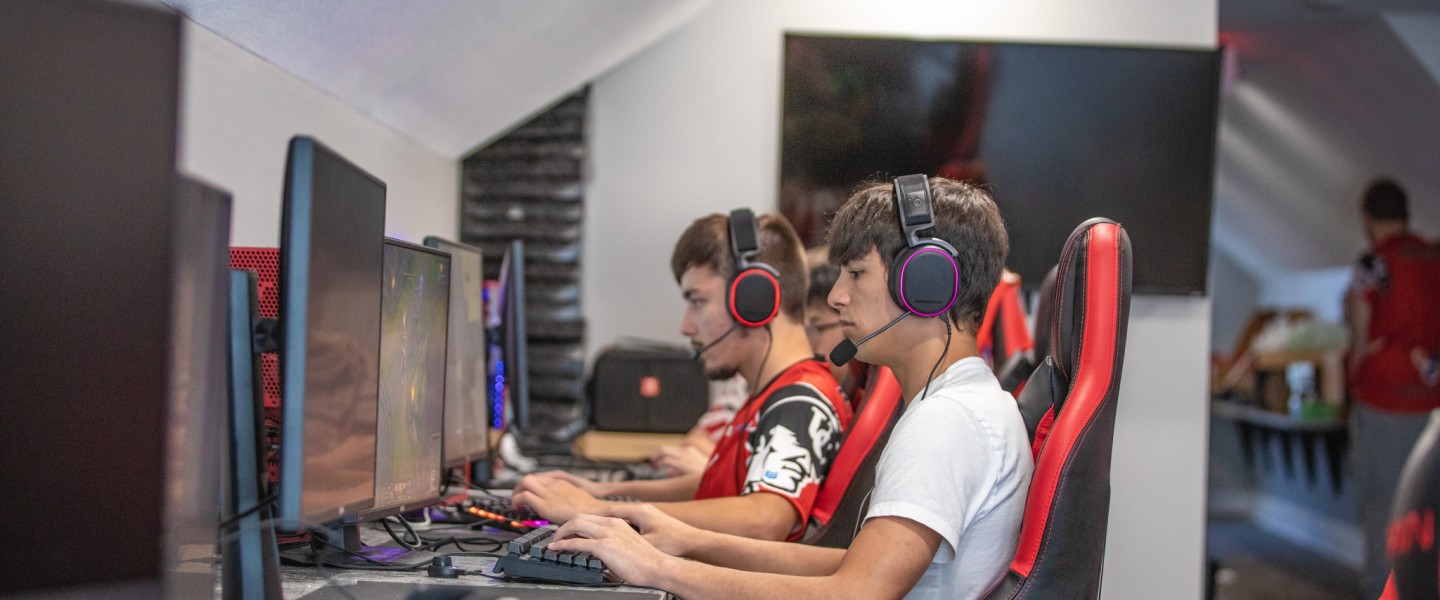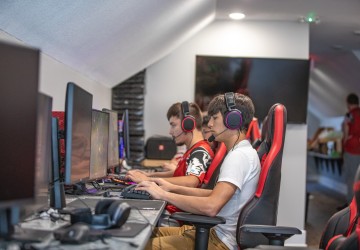If you're at all familiar with modern gaming, you've likely noticed the rapid rise of esports. This quickly growing industry promises something for everyone: exciting and accessible entertainment for spectators, marketing opportunities for game developers, and a whole lot of fun for gamers. Keep reading to learn why college esports is such a big deal.
What Is Esports in College?
College esports combines the organizational structure of traditional sports with the thrill of competitive gaming. It differs from standard esports in that participants join teams affiliated with the colleges they attend. These esports teams compete against one another through various leagues — and members often have the opportunity to earn significant scholarships.
Why Are College Esports Growing?
Esports represents one of the fastest growing activities in college. Reasons for this gaming revolution abound, but it's impossible to truly grasp current and future possibilities without understanding just how far esports have come in a few short years.
The History of College Esports
College and competitive gaming have gone hand-in-hand for decades. In fact, the world's first recorded video gaming tournament took place at Stanford University, when computer science students were encouraged to participate in the "Intergalactic Spacewar Olympics."
Since then, competitive gaming has helped college students bond while finding stress relief during the sometimes stressful college experience.
While students have long brought a competitive element to gaming, it largely remained a small-scale, campus-based practice until the early 2010s. Tespa helped lead the way towards the modern iteration of competitive gaming, beginning as the Texas eSports Association. Partnering with top developer Blizzard, the organization hosted wildly successful League of Legends (LoL) tournaments.
This was quickly followed by the development of several college teams, including the founding of University of the Cumberlands' own esports team in 2017.
While Tespa and Blizzard deserve much of the credit for elevating esports, gaming developer Riot delivered the most impressive transformation. Riot's goal: to convince colleges to treat esports like conventional sports such as football or basketball. Accomplishing this meant formalizing the practice and adding scholarships to the mix.
The Influence of Developers
The swift rise in college esports can be attributed, in part, to the considerable interest shown by today's top developers. These companies have a vested interest in getting college students excited about — and firmly committed to — esports.
This represents an exceptional marketing opportunity. After all, esports differ from traditional sports in that each "activity" is also a product. This forces leagues to work closely with developers such as Blizzard and Riot.
College as the Minor Leagues of Esports
While some esports players are able to go professional while still attending college, many view this time as a tenure in the esports version of a minor league — or even the equivalent to college football. Those who perform impressively as college students stand an excellent chance of eventually becoming professional esports athletes. Meanwhile, they can earn their degrees, often supported by scholarships from tournaments or other sources.
Recent Changes to Esports
While COVID has brought some challenges to college esports (including the sudden shutdown of the formerly instrumental Tespa), competitive gaming has continued to garner a ton of interest among students.
In some ways, the pandemic proved just how resilient esports can be, as travel limitations were less of a problem for competitive gamers than in traditional sports. With students temporarily unable to participate in athletic activities on campus, many colleges began to develop new esports teams to accommodate the growing interest.
With more teams comes the need for more competitions and leagues. Hence, the increased importance of governing bodies such as NAC Esports. Currently, NACE boasts nearly 200 member colleges, while CollegiateR6 (CR6) has nearly 300 teams. Many other teams exist but are affiliated with alternate esports leagues.
The rapid growth of college esports reflects that of competitive gaming in general. The gaming analytics firm Newzoo projects an esports audience of 577.2 million by 2024. Revenue streams from sponsorships and media rights are expected to exceed $1.1 billion by then.
What Esports Games Are Played in College?
Esports is an increasingly diverse practice, in which a variety of games can be used to drive competition between individual gamers and college teams. New games are added all the time, but the following are currently among the most popular:
1. Rocket League
Players team up to zoom, bounce, and rocket around the arena, all striving to score a goal for their team. Highlight reel goals have kept players and viewers alike hooked on Rocket League since its release in 2015.
2. League of Legends
An immensely popular MOBA (Multiplayer Online Battle Arena), League of Legends is easy to pick up and play but nearly impossible to master. This has made it an enduring esports favorite — and one of the most streamed games on Twitch.
3. Valorant
Riot Games followed up League of Legends with another home run in Valorant. A tactical first person shooter (FPS) hero shooter, Valorant combines the best of Counter-Strike with some of Overwatch's character-centric flavor.
4. Rainbow Six: Siege
The added element of destruction has made Rainbow Six: Siege stand out from the tactical shooter crowd. While Siege's Operators aren't as unique and varied as the heroes in other games, they still offer something for every type of player.
5. Call of Duty: Warzone
The venerable Call of Duty franchise has received a new entry every November for more than a decade. That being said, the free-to-play Warzone game mode has somehow managed to make this mega-popular franchise even more of a success. No other FPS plays quite like Call of Duty — and adopting the battle royale formula has exposed it to a new generation of players.
6. Hearthstone
Yet another massive hit game from Blizzard, Hearthstone's free-to-play card collecting game shows no signs of slowing down. With over 100 million registered users, it remains a favorite in the esports community.
7. Overwatch
The game that popularized the term "hero shooter," Blizzard's Overwatch is always evolving. Every player has a favorite hero — and they all bring something unique to the crazy 6v6 online battles.
8. Fortnite
A cultural phenomenon that's more than just meme-worthy dances and product placement, Fortnite took the battle royale genre mainstream. Up to 100 different players duke it out in a last-player-standing shootout where fast-twitch gaming skills and creative fortress building are key to victory.
9. Super Smash Bros. Ultimate
Nintendo's flagship fighting game lets players battle it out with iconic figures such as Mario and Donkey Kong. Frenetic arena-style combat creates memorable moments in every battle. Ultimate continues to build off the Smash Brothers legacy established more than two decades ago.
College Esports Leagues
Official leagues bring structure to the rapidly evolving world of college esports. The following are currently among the most notable esports leagues:
1. NAC Esports
Founded in 2016, the National Association of Collegiate Esports (NAC) is one of the original forces in the realm of organized college esports.
With the NCAA Board of Governors turning down esports as of 2019, NAC has largely been called on to fill the void. Many enthusiasts credit NAC with bringing a more legitimate feel to esports.
2. PlayVS
Chief business officer Aakash Ranavat regards PlayVS as less of a traditional league and more of a framework for navigating the complex and ever-changing esports realm. He claims that PlayVS has "built the most robust platform to be able to essentially run esports seasons and competitions across the various IPs on our platform."
3. CollegiateR6
With hundreds of participating universities and well over 2,000 student athletes, CR6 serves the many students and teams who adore the game Rainbow Six: Siege. Prize pools valued at over $20,000 make this a compelling option for many a college esports club.
4. NCAA
As mentioned previously, the NCAA has opted to skip the esports phenomenon for the time being. However, it's possible that this decision could be reversed in the future. After all, consulting firm Intersport (which was brought in to advise NCAA on the matter) actually recommended that the organization take a chance on competitive gaming.
Esports Scholarships
As mentioned previously, scholarships have played an integral role in bringing esports into the college mainstream. They are also an important tool for esports recruiting. Just as high school football and basketball players are enticed by traditional athletic scholarships, esports players are eager to enroll at colleges that provide generous scholarship packages.
While this is just one of several considerations worth taking into account when selecting a college and its associated esports club, it can provide a compelling argument for those not sure whether to proceed with college or dive straight into professional esports. When seeking college scholarships, look for institutions with varsity esports programs, as these are the most likely to provide financial support for team members.
Between tournaments and scholarships, the future is bright for college esports. Whether you want an opportunity to build strong relationships with team members, earn a scholarship, or simply spend more time playing video games, there's a lot to be gained by joining a college esports club.
If you are interested in learning more about the college esports programs at University of the Cumberlands, contact an admissions counselor or request more information today.

